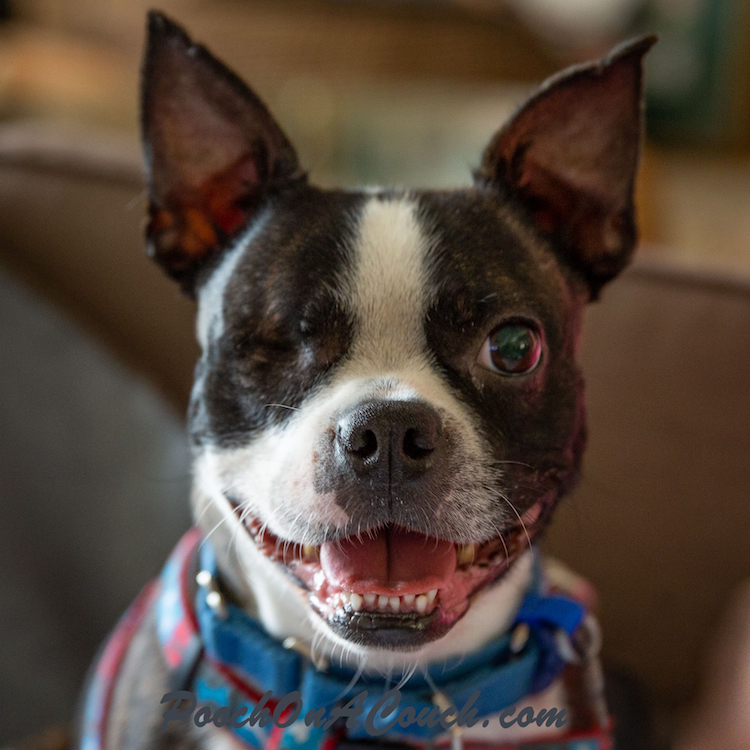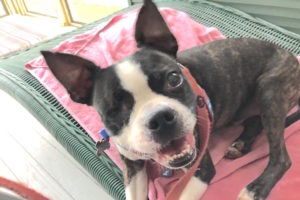Remind Me: What Is That Routine I Normally Use?
Ah – the challenges of bringing home a new foster dog. The first week with a new foster dog is not easy, and trying to remember how I’d perfected the “keep separate and rotate” routine added to each end-of-the-day exhaustion. It is no fun to witness two dogs in a confrontation. I’ve certainly had one too many unplanned encounters and I try really hard to learn from my mistakes.
Luckily, both dogs adjusted almost immediately to the routine, and Otis, my sweet boy, gave a heavy sigh – yes, mama is fostering another dog for a little while.
Carter's Overall Health
We Had A Quickie!
I dropped by the rescue’s veterinarian for a quickie physical exam and learned that Carter has evidence of a cataract in his only eye. His vision is OK at the moment, but regular re-checks of the eye is recommended.
He also has a grade 3 medial patellar luxation, (MPL) also called a floating kneecap. This is where the kneecap moves in and out of the groove in the knee. An MPL is an important diagnosis for several reasons:
- Carter is a few pounds overweight, and losing this weight will help reduce unnecessary strain to the knee.
- As I train with Carter, I need to make sure to ask for alternate default behaviors to a “sit” as asking him to repeatedly hyperflex that knee can cause him to feel a strain.
- Supplements like Omega 3s and Dasuquin can help provide holistic support.
- I need to provide him with the appropriate type and duration of exercise to strengthen muscles that support the knee as well as avoid further injury, such as a torn ACL.
- Surgery is not in his near future; Treating his heartworm disease is a priority.
For more information on patellar luxation, read here.
Knowing that he has a cataract in his only eye reminds me to be keen on any challenges he has during various lighting conditions or any reactivity he may have when he feels like he cannot see. Dogs with cataracts sometimes cannot see in direct sunlight or very dim light. Nighttime vision can also be impaired. Read more about canine cataracts here.
Booooooo Heartworms!
The sad news is: his heartworm treatment was not administered correctly, and this means he probably still has heartworms in his heart. We need to repeat the final phase of his treatment – two Immiticide injections administered 24 hrs apart – followed by 30 days of heavily restricted activity. At the time this blog post goes public, he will be receiving the treatments at the clinic. I pick him up Wednesday, September 19th.
(The American Heartworm Society recently released their brand new guidelines on prevention & treatment. Read up!)
Who Is This New Foster Dog?
Mr. Smarty Pants
Well, little Carter is smart as a whip! He is desperate for human interaction. He works so hard for praise and for attention, dropping his rump to the ground like it’s hot in hopes I’ll stop what I’m doing and give him lovin’ rubs. Someone in his past gave him a lot of attention for offering a “sit”, I can tell!
I introduce him to a new behavior and he learns it quickly. Some dogs are very food motivated, and Carter is, too, but he also loves hearing the words, “good boy!” His eye lights up when you praise him. It makes training so much easier when I don’t need to fumble with the treat bag to give him food reinforcements. Food is a strong motivator, so I still rely on using food as I train him.
So far, he’s learned 4 hand/verbal cues: down, stay, come, and touch. We are working on “spin”,(for fun!) “get on your bed” and “leave it.” Most of these behaviors are chosen to help Carter with his impulse control and encourage him to connect with me for directions.
Me First?
Carter hasn’t quite figured out what a relationship with a human truly can be. Right now, it’s sorta one-sided. He sees me as his servant with opposable thumbs. I’m not here to open up doors for him, to put food in his bowl for him, and to make my lap available for his snuggles whenever he wants. I do have to open up doors for him if I want him to eliminate his waste outside or if I want the two of us to take a short walk, but I can also ask that he not push me out of the way to exit the doorway first. But, I can ask that he wait for me to place the food bowl down on the floor instead of knocking it out of my hands, scattering food all over the floor. Snuggles are nice, and I like them, too. However, I want to be able to comfortably drink my coffee and read my books while snuggling. My expectations of him are reasonable and I want him to have some control of his eagerness. It’s that balance of relationship he’s missing. He will get it!
No More Puppy Play!
Puppy play and mouthing behaviors have yet to be extinguished in this 4-5-year-old dog. He’s used to mouthing hands, more so than playing with toys. When I get down on the floor with him, his behavior escalates in excitement and he becomes more interested in my face like a puppy would. He caused a very mild injury to my lip by lunging at me with an open mouth. It wasn’t an intentional bite, but I’m taking this behavior pretty seriously, and at this point, I would not have him around children.
I’m working to extinguish this behavior similar to how his littermates would react if he played this way with them. What puppies do: if their littermate is becoming obnoxious, rude, or painful in their play, puppies will walk away. “I’m not playing if you are going to play like that!” It’s natural training at it’s best!
No Dog For You
Despite no problems with Otis or Carter reacting to the sight of each other (so grateful for this) I still have a hunch that Carter has some social fears and reactivity. I’m not sure yet if it is resource guarding or if it is fear/reactivity. Otis is this way, too, and I’m overly cautious. These two will not freely interact anytime soon.
I noticed this: Carter seems curious but distrusting of Otis. He’s watchful and comfortable to approach at the baby gate, it’s another thing to have him and Otis in the same room, safely a good distance apart. I tried this arrangement a few nights ago. Otis simply turned his body away, ignored Carter, and took a nap. Carter remained on high alert with his eyes large and his brow furrowed. Ears pinned back. He was worried! He never escalated, but after 10 minutes, I knew the kind thing to do was to stop the exposure and put Carter away. He was grateful. He curled up in his crate and went right to sleep.
I’m thinking and reading about how to best help Carter. I admit: I am afraid of a dog fight, but I also know that fences and tethers and containment in crates can increase social anxiety and aggressive behavior in dogs. I certainly do not want to cause that, and may seek professional guidance. Improving my confidence in assessing sociability in dogs is important.
Accomplishments and Next Steps
What we’ve accomplished/learned this week:
- Carter is pretty much house-trained.
- The crate is his preferred safe place.
- He’s unsure of new sounds, places, objects, but is curious. So far, no issues with storm noises.
- Nighttime vision is impaired a little. He’s also more fearful outdoors at night.
- He wants to please and is tender-hearted. Verbal corrections need to be used rarely and judiciously, if at all.
- He learns FAST.
- While eager and excitable, he is remarkably patient.
- I think he’s lost a little weight this week!
Next week’s goals:
- Continue to (carefully) work on more age-appropriate play behaviors and extinguish puppy lunging.
- Practice loose-leash walking on and off the home property.
- Consistently use the “wait” cue when opening doors and at mealtime.
- Introduce more impulse control games such as sit/stays with distance and down/stays with distance.
- Practice “leave it”.
- Provide mental stimulation games as Carter will be on activity restriction for heartworm treatment. We do not want him to become frustrated with his confinement, but need to keep him calm!
- Continue careful exposure to new experiences and assess his recovery.
- Continue weight reduction!




